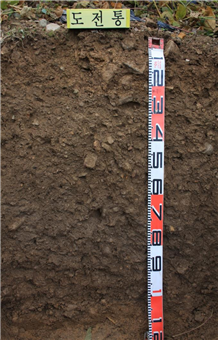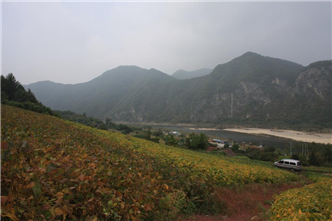

Morphological properties of typifying pedon.
|
|
DOJEON SERIES |
Established Series PCS, JYH 10 Nov., 1979 |
The Dojeon series are members of the fine loamy, mixed, mesic family of Typic Hapludults [Cutanic Alisols (Alumic Hyperdystric) classified by WRB]. These soils have brown gravelly silt loam Ap horizons, yellowish brown gravelly clay loam BA horizons, brown gravelly clay loam Bt1 horizons, brown gravelly clay loam Bt2 horizons, and yellowish brown gravelly clay loam Bt3 horizons. These soils are on mountain foot slopes and formed in colluvium from limestones.
Typifying Pedon: Dojeon gravelly loam-sesame (Colors are for moist soil).
Slope: 7-15%
Elevation: 212 m above m.s.l.
Soil moisture regime: Udic
Soil temperature regime: Mesic
Parent material: Colluvium from limestone
Diagnostic features: An ochric epipedon from a depth of 0 to 10 cm and an argillic horizon from a depth of 25 to 145 cm (An argic horizon from a depth of 25 to 145 cm by WRB).
Described by: Song, K. C., D. C. Noh, and S. J. Jung, 14 Oct., 2010.
|
|
|
|
|
Morphological properties of typifying pedon. |
||
Ap - 0 to 10 cm. Brown (10YR 4/3) gravelly silt loam; moderate medium to coarse granular structure; friable, slightly sticky and plastic; common very fine to medium roots; few medium pores; few worm holes; 20% gravels; clear wavy boundary.
BA - 10 to 25 cm. Yellowish brown (10YR 5/4) gravelly clay loam; moderate fine to medium subangular blocky structure; friable, sticky and plastic; thick patch clay cutans; few very fine to fine roots; common medium to coarse pores; few worm holes; 30% gravels; clear wavy boundary.
Bt1 - 25 to 62 cm. Brown (10YR 5/3) gravelly clay loam; moderate fine to medium subangular blocky structure; friable, sticky and plastic; thin continuous clay cutans; few very fine roots; common medium to coarse pores; few worm holes; 30% gravels; clear wavy boundary.
Bt2 - 62 to 91 cm. Brown (10YR 4/3) gravelly clay loam; moderate medium subangular blocky structure; friable, sticky and plastic; thin continuous clay cutans; few very fine roots; many fine to medium pores; few worm holes; 25% gravels; clear wavy boundary.
Bt3 - 91 to 145 cm. Yellowish brown (10YR 5/6) gravelly clay loam; moderate fine to medium subangular blocky structure; friable, very sticky and very plastic; thick patch clay cutans; no roots; common medium to coarse pores; 25% gravels.
The typifying pedon has an ochric epipedon from a depth of 0 to 10 cm and an argillic horizon from a depth of 25 to 145 cm. It has a base saturation (by sum of cations) of less than 35% at 125 cm below the upper boundary of the argillic horizon. That can be classified as Ultisol. It has an udic soil moisture regime, and can be classified as Udult. Also it meets the requirements of Typic Hapludult.
The typifying pedon has in the fraction less than 75 mm in diameter, 15% or more particles with diameters of 0.1 to 75 mm and in the fine-earth fraction, 18 to 35% clay at the particle-size control section and has mesic soil temperature regime. Therefore it can be classified as fine loamy, mixed, mesic family of Typic Hapludult.
Type Location: About 250 meters S-oil Oline Station, Sapyeong Ri, Gagog Myeon, Danyang Gun, Chungcheongbug Do (128° 23' 59.4'', 37° 02' 2.4'').
Range in Characteristics: These soils have ochric epipedons and argillic horizons. The solum thickness ranges from 100 to 150 cm and depth to hard rock is more than 2 meters. Reaction is strongly to slightly acid. Base saturation is less than 60 percent. These soils have 10 to 35 percent gravels and cobbles. These soils have brown or dark yellowish brown Ap horizons; brown, dark yellowish brown, brownish yellow, yellowish brown, or light yellowish brown gravelly clay loam Bt horizons.
Competing Series and Their Differentiae: These are the Anryong, Bongsan, and Asan soils. The Anryong soils are derived from acidic colluvial materials. The Bongsan soils occur on rolling to hilly areas and are derived from porphyry materials. The Asan soils occur on rolling to hilly areas and are derived from granite gneiss, micaceous schist, and similar materials.
Setting: The Dojeon soils are on mountain foot slopes and formed in colluvium from limestones. The slope ranges from 2 to 30 percent.
Principal Associated Soils: These are the Mosan and Pyeongchang in residuum from limestones, the Maji and Pyeongjeon soils in lower positions.
Drainage and Permeability: Well drained; moderate or moderately slow permeability; medium runoff.
Use and Vegetation: Used for upland crops.
Distribution and Extent: The Dojeon soils occur in colluvium from limestones throughout the country. These soils are inextensive.
Series Established: Danyang Gun, Chungcheongbug Do, 1978. Revised, Danyang Gun, Chungcheongbug Do, 2010.
Laboratory data sheets of typifying pedon.
|
Depth (cm) |
Horizon |
( --- Total ---) |
(-- Clay --) |
(-- Silt --) |
(------- Sand -------) |
||||||||
|
Clay |
Silt |
Sand |
Fine |
Coarse |
Fine |
Coarse |
VF |
F |
M |
C |
VC |
||
|
LT |
.002 |
.05 |
LT |
LT |
.002 |
.02 |
.05 |
.10 |
.25 |
.5 |
1 |
||
|
.002 |
- .05 |
- 2 |
.0002 |
.002 |
- .02 |
- .05 |
- .10 |
- .25 |
- .50 |
- 1 |
- 2 |
||
|
- - - - - - - - - - - Pct of ˂ 2mm (3A1) - - - - - - - - - - - |
|||||||||||||
|
0-10 |
Ap |
19.9 |
49.2 |
30.9 |
|
|
29.3 |
19.9 |
3.0 |
6.9 |
6.6 |
8.2 |
6.3 |
|
10-25 |
BA |
20.5 |
51.6 |
28.0 |
|
|
29.5 |
22.2 |
3.0 |
6.7 |
6.5 |
7.6 |
4.2 |
|
25-62 |
Bt1 |
27.5 |
33.1 |
39.4 |
|
|
13.0 |
20.1 |
3.8 |
8.3 |
10.6 |
9.8 |
6.8 |
|
62-91 |
Bt2 |
27.6 |
33.9 |
38.5 |
|
|
11.0 |
22.9 |
3.1 |
7.6 |
7.5 |
10.5 |
9.8 |
|
91-145 |
Bt3 |
29.3 |
35.1 |
35.6 |
|
|
11.5 |
23.6 |
2.8 |
6.7 |
7.4 |
10.2 |
8.6 |
|
Depth (cm) |
Coarse Fractions(mm) |
˃2mm |
Orgn |
Total |
Extr |
Total |
(-- Dith -Cit --) |
|||||
|
Weight |
Wt |
C |
N |
P |
S |
Extractable |
||||||
|
2-5 |
5-20 |
20-75 |
.1-75 |
Pct of |
|
|
|
|
Fe |
Al |
Mn |
|
|
|
|
|
|
Whole |
6A1c |
6B3a |
6S3 |
6R3a |
6C2b |
6G7a |
6D2a |
|
|
Pct of ˂ 75mm (3B1) |
Soil |
Pct ˂ 2mm |
g/kg |
Pct of ˂ 2mm |
||||||||
|
0-10 |
|
|
|
|
|
1.73 |
|
|
|
|
|
|
|
10-25 |
|
|
|
|
|
0.92 |
|
|
|
|
|
|
|
25-62 |
|
|
|
|
|
0.53 |
|
|
|
|
|
|
|
62-91 |
|
|
|
|
|
0.51 |
|
|
|
|
|
|
|
91-145 |
|
|
|
|
|
0.34 |
|
|
|
|
|
|
|
Depth (cm) |
Ratio/Clay |
Atterberg |
( Bulk Density ) |
COLE |
(- Water Content -) |
WRD |
|||||||
|
CEC |
1500 |
Limits |
Field |
33 |
Oven |
Whole |
Field |
10 |
33 |
1500 |
Whole |
||
|
|
kPa |
LL |
PI |
Moist |
kPa |
Dry |
Soil |
Moist |
kPa |
kPa |
kPa |
Soil |
|
|
8D1 |
8D1 |
4P1 |
4P |
4A3a |
4A1d |
4A1h |
4D1 |
4B4 |
4B1c |
4B1c |
4B2a |
4C1 |
|
|
|
|
Pct ˂0.4mm |
- - g/cc - - |
cm/cm |
-- Pct of ˂2mm -- |
cm/cm |
|||||||
|
0-10 |
0.64 |
|
|
|
|
|
|
|
|
|
|
|
|
|
10-25 |
0.54 |
|
|
|
|
|
|
|
|
|
|
|
|
|
25-62 |
0.46 |
|
|
|
|
|
|
|
|
|
|
|
|
|
62-91 |
0.41 |
|
|
|
|
|
|
|
|
|
|
|
|
|
91-145 |
0.38 |
|
|
|
|
|
|
|
|
|
|
|
|
|
Depth (cm) |
( NH4OAc Extractable Bases ) |
Acid- |
Extr |
(----- CEC -----) |
Al |
||||||
|
Ca |
Mg |
K |
Na |
Sum |
ity |
Al |
Sum |
NH4- |
Bases |
Sat |
|
|
5B5a |
5B5a |
5B5a |
5B5a |
Bases |
|
|
Cats |
OAc |
+ Al |
|
|
|
6N2e |
6O2d |
6Q2b |
6P2b |
|
6H5a |
6G9a |
5A3a |
5A8b |
5A3b |
5G1 |
|
|
- - - - - - - - - - - - meq / 100g - - - - - - - - - - - - |
Pct |
||||||||||
|
0-10 |
5.7 |
1.3 |
0.4 |
0.1 |
7.4 |
8.9 |
0 |
16.4 |
12.8 |
7.4 |
0 |
|
10-25 |
3.9 |
1.1 |
0.3 |
0 |
5.4 |
8.4 |
0.4 |
13.8 |
11.0 |
5.8 |
7.4 |
|
25-62 |
1.6 |
0.5 |
0.2 |
0 |
2.2 |
14.1 |
2.1 |
16.3 |
12.6 |
4.4 |
48.8 |
|
62-91 |
1.4 |
0.4 |
0.1 |
0 |
1.9 |
12.9 |
2.4 |
14.8 |
11.3 |
4.3 |
55.2 |
|
91-145 |
2.3 |
0.3 |
0.2 |
0 |
3.0 |
9.9 |
0.7 |
12.9 |
11.0 |
3.7 |
19.6 |
|
Depth (cm) |
(Base Sat) |
CO3 as |
Res |
Cond |
(------ pH ------) |
Acid Oxalate Extraction |
|||||||
|
Sum |
NH4- |
CaCO3 |
|
|
NaF |
KCl |
CaCl2 |
H2O |
Opt |
Al |
Fe |
Si |
|
|
|
OAc |
˂2mm |
|
|
|
|
.01M |
|
Den |
|
|
|
|
|
5C3 |
5C1 |
6E1g |
8E1 |
8I |
8C1d |
|
8C1f |
8C1f |
8J |
6G12 |
6C9a |
6V2 |
|
|
---- Pct ---- |
ohms/cm |
dS/m |
|
1: 1 |
1: 2 |
1: 1 |
|
- Pct of ˂2mm - |
|||||
|
0-10 |
45.5 |
58.2 |
|
|
|
|
5.0 |
5.5 |
6.1 |
|
|
|
|
|
10-25 |
38.8 |
48.6 |
|
|
|
|
4.3 |
5.0 |
5.7 |
|
|
|
|
|
25-62 |
13.7 |
17.8 |
|
|
|
|
3.8 |
4.2 |
5.1 |
|
|
|
|
|
62-91 |
13.0 |
17.0 |
|
|
|
|
3.8 |
4.2 |
5.1 |
|
|
|
|
|
91-145 |
23.2 |
27.2 |
|
|
|
|
4.1 |
4.7 |
5.6 |
|
|
|
|